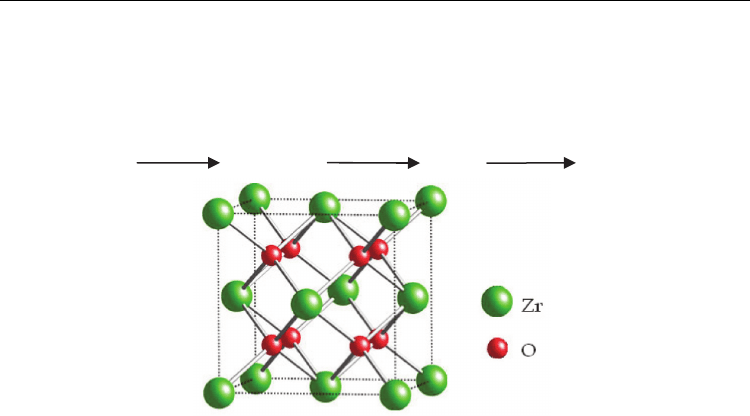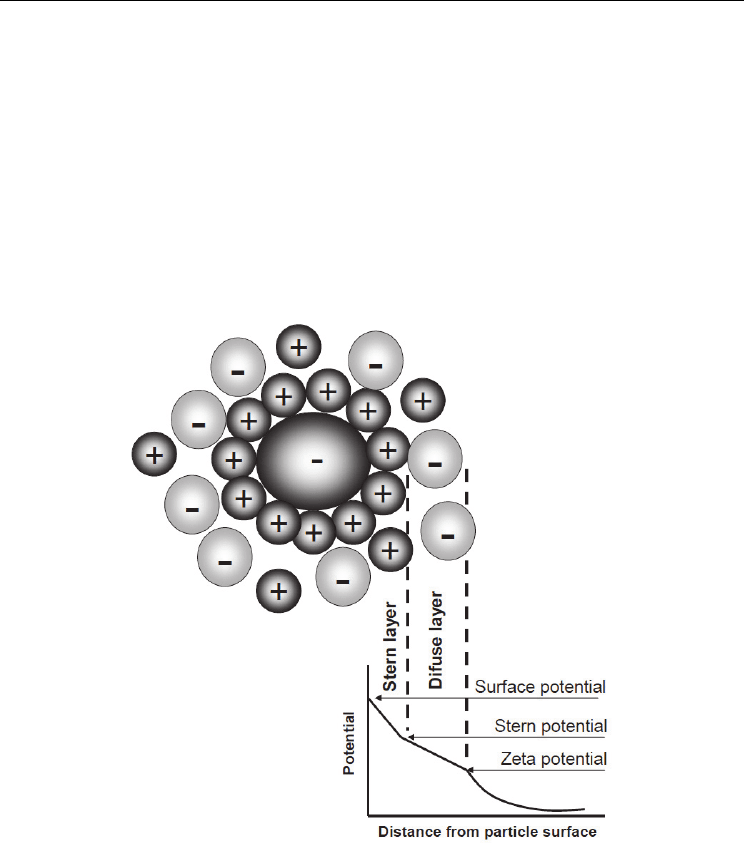Sikalidis C. (ed.) Advances in Ceramics - Synthesis and Characterization, Processing and Specific Applications
Подождите немного. Документ загружается.


Ceramic Materials for Solid Oxide Fuel Cells
429
Dutta et al., 2009 synthesized different perovskites with different dopants (La
0.8
Sr
0.2
FeO
3-
;
La
0.8
Sr
0.2
Co
0.8
Fe
0.2
O
3-
and La
0.5
Sr
0.5
Co
0.8
Fe
0.2
O
3-
) by a combustion synthesis technique.
According to their results La
0.5
Sr
0.5
Co
0.8
Fe
0.2
O
3-
shows the highest electrical conductivity and
superior electrochemical performance. Highest current density of approximately 1.72 A.cm
-2
and power density of 1.2 W.cm
-2
at 0.7 V, at a operating temperature of 800
°
C, is obtained with
this cathode composition and YSZ electrolyte (~10 µm) with GDC interlayer (~15 µm). The
value of total area specific resistance (ASR) of this cathode is approximately 0.211 A.cm
2
.
LSCF-based cathodes have a lower ASR than LSM perovskites but they are incompatible
with YSZ electrolytes due to undesirable interface reactions. Therefore, Ceria based
electrolytes such as gadolinia doped ceria (GDC) are used with LSCF cathodes (Uhlenbruck
et al., 2009). Furthermore, the TEC values of the GDC electrolytes (12.8×10
−6
K
−1
) better
match that of the LSCF’s (equal or greater than 17×10
−6
K
−1
. ).
Many other perovskites are used as cathodes in SOFC such as: Pr
0.5
Sr
0.5
FeO
3-
;
Sr
0.9
Ce
0.1
Fe
0.8
Ni
0.2
O
3-
; Sr
0.8
Ce
0.1
Fe
0.7
Co
0.3
O
3-δ;
LaNi
0.6
Fe
0.4
O
3-
(LNF); Pr
0.8
Sr
0.2
Co
0.2
Fe
0.8
O
3-
;
Pr
0.7
Sr
0.3
Co
0.2
Mn
0.8
O
3-
; Pr
0.8
Sr
0.2
FeO
3-
; Pr
0.6
Sr
0.4
Co
0.8
Fe
0.2
O
3-
; Pr
0.4
Sr
0.6
Co
0.8
Fe
0.2
O
3-
;
Pr
0.7
Sr
0.3
Co
0.9
Cu
0.1
O
3-
; Ba
0.5
Sr
0.5
Co
0.8
Fe
0.2
O
3-
; Sm
0.5
Sr
0.5
CoO
3-
; LaNi
0.6
Fe
0.4
O
3-
(Sun et al.,
2010). Their features will not be addressed in this work.
2.2 Electrolyte
The electrolyte is the component of the cell responsible for conducting ions between the
electrodes, for the separation of the reacting gases and for the internal electronic conduction
blocking, forcing the electrons to flow through the external circuit (Singhal & Kendall, 2001).
Without significant ion conduction, no current would pass through the cell and only a
potential difference would be detected. There are three types of electrolytes that differ by the
ion transport mechanism: anionic, protonic and mixed ionic. However, most of the high
temperature fuel cells operate via oxygen ion (O
2-
) conduction from the air electrode to the
fuel electrode. This conduction occurs because of the presence of oxygen ions vacancies, so
the crystallites forming the electrolyte must have unoccupied anionic sites. The energy
required for the oxide ion migration from one site to the neighboring unoccupied equivalent
site must be small (Faro et al., 2009).
For satisfactory performance, the electrolyte must meet some requirements that limit the
choice of the material. These include (EG&G Technical services, 2000; Fergus et al., 2009;
Singhal & Kendall, 2001): (1) an oxide-ion conductivity
greater than10
−2
S.cm
−1
at the
operating temperature; (2) negligible electronic conduction, which means an electronic
transport number close to zero; (3) high density to promote gas impermeability; (4)
thermodynamic stability over a wide range of temperature and oxygen partial pressure; (5)
TEC compatible with that of the electrodes and other cell materials from ambient
temperature to cell operating temperature; (6) suitable mechanical properties, with fracture
resistance greater than 400 MPa at room temperature; (7) negligible chemical interaction
with electrode materials under operation and fabrication conditions to avoid formation of
blocking interface phases; (8) ability to be elaborated as thin layers (less than 30
m); (9) low
cost of starting materials and fabrication.
Zirconia based ceramic materials have been the most investigated and developed
electrolytes for high temperature use. At room temperature, pure zirconia is monoclinic. At
1170 °C, it undergoes a phase transition to a tetragonal structure with a large volume

Advances in Ceramics - Synthesis and Characterization, Processing and Specific Applications
430
change. Above 2370 °C, pure zirconia is transformed into the cubic fluorite structure. The
cubic phase still remains up to the melting point at 2680 °C as showed below (Faro et al.,
2009; Fergus et al., 2009). The fluorite lattice is an interpenetration of a cubic oxygen lattice
in the middle of the face-centered cubic zirconium lattice (Fig. 6).
Fig. 6. Unit cell of zirconia fluorite (Adapted from Crystal Maker ® Demonstration version)
Doping zirconia with aliovalent ions is a common practice to stabilize the cubic fluorite
structure from room temperature up to its melting point. The doping process increases the
oxygen vacancy concentration, and consequently improves the ionic conductivity.
According to the Kröger-Vink notation (Mitchell, 2004) for a typical trivalent dopant, M, the
oxygen vacancies formation can be represented as:
2
'*..
23
23
ZrO
Zr o o
M
nO M O V (4)
So oxygen vacancies doubly ionized are produced at concentrations proportional to the
dopant content.
The main dopants of zirconia are CaO, MgO, Y
2
O
3
, Sc
2
O
3
, Sm
2
O
3
and Yb
2
O
3
(Table 2). They
exhibit high solubility in the zirconia fluorite structure . Among these, the most frequently
used is Y
2
O
3
followed by Sc
2
O
3
.
The conductivity of doped zirconia depends on the dopant concentration. Several studies
show that the conductivity of zirconia increases with adding Y
2
O
3
until 8 mol % and then
decreases for higher yttria additions. (Y
2
O
3
)
0.08
(ZrO
2
)
0.92
is widely employed as an electrolyte
material in high temperature SOFCs because of its sufficient ionic conductivity and stability
in both oxidizing and reducing environments. Beyond that, its components are abundant,
inexpensive and it is easy to produce (Tarancón, 2009). Yttria doped zirconia (YSZ) is also
stable in contact with a lot of electrode materials below 1100°C. Unfortunately, La and Sr
containing cathodes, react with YSZ at higher temperature producing insulating phases
such as La
2
Zr
2
O
7
and SrZrO
3
at the cathode-electrolyte interface. It blocks the ion migration
(EG&G Technical services, 2000; Brant, 2006).
Scandia doped zirconia (ScSZ) has drawn attention for its utilization as electrolyte because
of its high ionic conductivity (Table 2). However, at high temperature, ScSZ suffers thermal
aging, reducing its conductivity. Its high ionic conductivity might enable the use of ScSZ at
Monoclinic 1170 °C tetra
g
onal 2370 °C cubic 2680 °C molten phase

Ceramic Materials for Solid Oxide Fuel Cells
431
intermediate temperatures, in which there is no significant degradation. The main limiting
factors in this case are the purity and availability of scandium oxide (Kharton et al., 2004).
Dopant Content (% mol) σ
i
at 1000 °C (S.cm
-1
) Activation energy (kJ.mol
-1
)*
Y
2
O
3
8 10.0 96
Sm
2
O
3
10 5.8 92
Yb
2
O
3
10 11.0 82
Sc
2
O
3
10 25.0 62
*96.488 kJ.mol
-1
= 1 eV
Table 2. Values of ionic conductivity and activation energy of zirconia stabilized with
different cations (adapted from Florio et al., 2004)
*
The characteristics of the electrolyte, mainly its ionic conductivity and thickness, determine
the operating temperature range of the SOFC. YSZ electrolyte cells operate satisfactorily
only at temperatures above 850 °C.. Doped CeO
2
and doped LaGaO
3
have shown promise
for the replacement of YSZ in intermediate temperature SOFCs (600-800 °C) (IT-SOFC) due
to their higher conductivity. Other new materials for use in IT-SOFC are salt-oxide
composite materials and NANOCOFC materials (nanocomposites for advanced fuel cell
technology) (Nesaraj, 2010; Raza et al., 2010).
When compared to stabilized zirconia, doped ceria presents ionic conductivities
approximately one order of magnitude greater, for similar temperature conditions. This is
due to the larger ionic radius of Ce
4+
(0.87 Å) as compared to Zr
4+
(0.72 Å) producing a more
open structure through which oxide ions can easily conduct (Faro et al., 2009).
Unlike zirconia, ceria naturally presents a fluorite structure since room temperature up to its
melting point at 2400 °C. So, in its case the only function of the doping is an increase of the
ionic conductivity through the formation of vacancies. The main doping cations used for
ceria are Gd
3+
, Sm
3+
and Y
3+
. Among them, Gd
3+
is the most commonly used. The ions Gd
3+
and Ce
4+
have the lowest ionic radius mismatch, so in the case of Gd doping the lattice
presents the smallest internal stress and consequently the lowest activation energy for the
O
2-
conduction (Fergus et al., 2009). The Ce
0.9
Gd
0.1
O
1.95
composition is promising for IT-
SOFC applications because of its high ionic conductivity at 500 °C ( Table 3).
Composition Dopant
σ
i
500 °C
(S.cm
-1
)
σ
i
600 °C
(S.cm
-1
)
σ
i
700 °C
(S.cm
-1
)
Ce
0.9
Gd
0.1
O
1.95
Gd
3+
0.0095 0.0253 0.0544
Ce
0.9
Sm
0.1
O
1.95
Sm
3+
0.0033 0.0090 0.0200
Ce
0.887
Y
0.113
O
1.9435
Y
3+
0.0087 0.0344 0.1015
Ce
0.8
Gd
0.2
O
1.9
Gd
3+
0.0053 0.0180 0.0470
Table 3. Ionic conductivities of the means dopants of ceria at different temperatures
(Adapted from Steele, 2000)

Advances in Ceramics - Synthesis and Characterization, Processing and Specific Applications
432
Beside its high ionic conductivity, gadolinium doped ceria (GDC) also is compatible with
the use of LSCF cathodes, since the chemical reaction between these materials is negligible.
Their TEC values are also fairly similar (Dutta et al., 2009). However, Ce
4+
reduces to Ce
3+
under the reducing anode atmosphere at elevated temperatures. This induces an electronic
conductivity (and phase changes) which decreases the open circuit voltage and increases the
fuel consumption, consequently reducing the cell performance (Nesaraj, 2010; Steele, 2000).
To avoid the Ce
4+
reduction, it is common to insert an YSZ thin film between the ceria
electrolyte and the anode (Dutta et al., 2009; Tietz et al., 2006). At temperatures lower than
500 °C the electronic conductivity is smaller and it has been suggested that this could be an
optimal operating temperature range for the fuel cells based on ceria (Kharton et al, 2004).
2.2.1 Doped lanthanum gallate
Oxygen conductors with perovskite cubic structure based on lanthanum gallate LaGaO
3
have also been investigated as SOFC electrolytes. In these ceramics, La can be partially
replaced by Sr, Ca, Ba, Sm and Nd, while Ga may also be partially replaced by Mg, In, Al or
Zn, as in La
1-x
Sr
x
Ga
1-y
Mg
y
O
3-δ
(LSGM). Compositions containing Sr and Mg substitutions
respectively for La (between 10 and 20%) and Ga (between 10 and 20%) showed high ionic
conductivities in both oxidizing and reducing atmosphere. Their TEC are comparable to the
other usual cell components. The higher ionic conductivity was found for the
La
0.8
Sr
0.2
Ga
0.83
Mg
0.17
O
3-δ
composition. It reaches about 0.17 S.cm
-1
at 800 ºC (Badwal, 2001).
However, these ceramics are unstable under reducing atmospheres and Ga losses are
observed, resulting in the formation of new phases (Kharton et al., 2004; Wincewicz
Cooper, 2004). These facts decrease the use of doped lanthanum gallate as SOFC electrolyte.
Composition σ
i
at 800 °C (S.cm
-1
) TEC (x10
-6
K
-1
)
(Y
2
O
3
)
0.08
(ZrO
2
)
0.92
10.5 0.03
(Sc
2
O
3
)
0.08
(ZrO
2
)
0.92
10.7 0.13
Ce
0.8
Gd
0.2
O
1.9
12.5 0.053
Ce
0.8
Sm
0.2
O
1.9
12.2 0.095
La
0.9
Sr
0.1
Ga
0.8
Mg
0.2
O
2.85
10.7 0.1
Table 4. Ionic conductivity and TEC of electrolyte materials in air at 800 °C (Adapted from
Sun et al., 2010)
*
2.3 Anode
The anode provides reaction sites for the electrochemical oxidation of the fuel gas. An
adequate anode has: (1) high electrical conductivity; (2) a TEC that matches those of the
adjoining components; (3) the capacity of avoid coke deposition; (4) fine particle size; (5)
chemical compatibility with another cell components (electrolyte and interconector) under a
reducing atmosphere at the operating temperature; (6) large TPB; (7) high electrochemical or
catalytic activity for the oxidation of the selected fuel gas; (8) high porosity (20 - 40 %)
adequate for the fuel supply and the reaction product removal; (9) good electronic and ionic
conductive phases (Florio et al., 2004; Singhal .& Kendall, 2003).

Ceramic Materials for Solid Oxide Fuel Cells
433
Ni/YSZ cermet (YSZ: yttria stabilized zirconia) is the most common anode material in the
SOFC which implement hydrogen as a fuel. The raisons for this choice are its low cost, its
chemical stability and its TEC closed to that of the YSZ electrolyte. The high catalytical
activity of Ni for the H-H bond breaking and its relatively low cost justify the use of Ni.
Other catalytic components including Cu, Co and phosphorous composites are being
investigated, but they need further improvements before they can be effectively used
(Florio et al., 2007; Martins et al., 2009; Sun et al., 2007).
The Ni particles coalescence is the main cause of the anode degradation. The YSZ grains
constitute a framework which acts as an inhibitor for the coarsening of the Ni powders
during cell operation. The TEC of nickel (16.9 × 10
−6
K
−1
) is much larger than that of YSZ
(11.0 × 10
−6
K
−1
); the use of YSZ as a composite component also makes the TEC of the
composite closer to those of other SOFC components. Furthermore, it improves the ionic
conductivity of the material (Badwal, et al., 2001; Florio et al., 2004).
The Ni to YSZ volume ratio usually varies from 35:65 to 55:45. This ratio influences in the
conductivity of the material. It may vary by several orders of magnitude (~0.1 S/cm to the
range of ~10
3
S/cm) because of the electrical conductivity of Ni which is more than 5 orders
of magnitude greater than that of YSZ under the fuel cell operating conditions. The choice of
an adequate composite composition is determining.
The cermet conductivity occurs through two mechanisms: ionic (through the YSZ phase)
and electronic (through the metallic nickel phase). For Ni concentrations below 30 % in
volume, the conductivity is predominantly ionic. Above 30 % in volume, it is predominantly
electronic (typical of metals). The electrical conductivity of the Ni/YSZ cermet attains its
maximum at Ni percolation estimated to be at approximately 30 % in volume (Amado et al.,
2007; Badwal, et al., 2001; Florio et al., 2004). The internal resistance (the resistance to the
transport of electrons within the anode), contact resistance (caused by poor adherence
between anode and electrolyte), concentration polarization resistance (related to the
transport of the gaseous species through the electrodes) and activation polarization
resistance (associated to the charge transfer processes) influence strongly the ASR of the
anode. The anode performance is also largely depending on its thickness, its microstructure
(grain size distribution, grain morphology, connectivity of Ni particles, porosity,) and
number of TPBs (Sun et al., 2007).
Through these parameters, the anode performance is also influenced by the sintering
temperature and the initial Ni and YSZ particle sizes. A fitting contact between Ni and YSZ
particles decreases both the anode bulk and interfacial resistances. A high sintering
temperatures (~1350–1400 °C) provides better anode performance and electrolyte interfacial
contact and limits Ni coarsening (Bao et al., 2005; Singhal & Kendall, 2003).
Anode films are employed as cell support with different thicknesses depending on the
SOFC cell design. In the planar designs, the thickness is about 1–3 mm.
For SOFC intended to use ethanol, methanol and gasoline or natural gas as fuels, the
Ni/YSZ composite is not a good choice, because of its low tolerance to sulfur and carbon
deposition. This problem can be avoided by reducing the operating temperature or by the
development of alternative anode materials.
Cu-anodes based on Cu/Ni alloys have been used but Cu is not as good an electrocatalyst as
Ni and with the YSZ electrolyte the power density is lower than with the Ni anodes. To
increase the activity and stability of the Cu-based anodes, Cu can be alloyed with a second
metal, for this purpose, nickel seems to be a good choice (Sun et al., 2007). Various metallic

Advances in Ceramics - Synthesis and Characterization, Processing and Specific Applications
434
alloys as components of the cermets such as (Cu, Co, Fe) Ni–YSZ; (Ni,Co)–YSZ; (Ni,Fe)–YSZ;
(Ni,Cu)–YSZ and (Cu,Co)-YSZ have been used for the direct oxidation of CH
4
(Benyoucef et
al., 2008; Ringuede et al., 2001).
Alternative materials which exhibit mixed ionic and electronic conductivity have been
investigated as potential SOFC anodes capable of reforming hydrocarbons. Ceramics based
on CeO
2
are good examples of mixed conduction materials under a reducing atmosphere,
(due to the partial reduction of Ce
4+
into Ce
3+
.) These ceramics have an excellent catalytic
activity for the hydrocarbon reforming reactions and they are resistant to carbon deposition.
This allows for a direct supply of dry hydrocarbon fuels to the anode (Ramirez-Cabrera et
al., 2000 as cited in Sun et al, 2007). The efficient catalytic activity of CeO
2
based materials
has been emphasized by Sun et al., 2006 as cited in Sun et al., 2007. The addition of Ni, Co or
a noble metal such as Pt, Rh, Pd or Ru which easily breaks the C-H bonds (Fergus et al.,
2009; Sun et al., 2007) in the hydrocarbons is a further improvement. For example, Ru-Ni-
GDC anodes used in a Ceria-based SOFC showed good results, with various hydrocarbons
according to Hibino et al., 2003 (see Table 6 for the materials performance).
New materials with the cubic perovskite structure have also been suggested as alternative
anode materials. The perovskite structure with general formula ABO
3
where A are cations
such as, La, Sr, Ca and Pb, etc and B cations such as Ti, Cr, Ni, Fe, Co and Zr exhibit a very
broad range of physical properties.
A La
0.6
Sr
0.4
Fe
0.8
Co
0.2
O
3–δ
- Ce
0.8
Gd
0.2
O
1.9
(LSFCO–GDC) composite anode materials and
La
0.75
Sr
0.25
Cr
0.5
Mn
0.5
O
3−δ
(LSCM) were investigated and are efficient anode electro-catalysts
(Huang et al., 2009; Morales et al., 2006; Sin et al., 2005; Sun et al, 2007). These materials
showed good performance and stability in methane-fed SOFC in absence of Ni or noble metal
catalysts. These anodes can be used withYSZ or GDC electrolytes. They are resistant to carbon
deposition. Some examples of cell performance and operating conditions are given in Table 6.
Another perovskite, A-site deficient, is the La-doped SrTiO
3
(LST). It has been evaluated as a
potential anode component for IT-SOFCs due to its thermal and chemical compatibilities
with the electrolyte material to its sulfur tolerance. Some researchers have reported a sulfur
poisoning by H
2
S in the range of 26 to 1000 ppm, others have reported no poisoning effect in
1000 ppm H
2
S and an enhancement effect in 5000 ppm. (Savaniu & Irvine, 2010; Yoo &
Choi, 2010).
La-doped SrTiO
3
(La
0.2
Sr
0.8
TiO
3
) is a candidate as an anode material to solve the problem of
Ni-based anode in LaGaO
3
-based SOFC according to Yoo & Choi (Yoo & Choi, 2010). Some
details of their tests are showed in Table 6. The addition of GDC into LST reduces the anode
polarization, leading to an increased performance.
The cell performance with Ni based anodes decreases quickly by sulfur poisoning which
generally becomes more severe as the temperature decreases or as the pH
2
S/pH
2
increases
(Fergus, et al., 2009; Sun et al., 2007). Matsuzaki et al., 2007 showed that SOFCs which utilize
Ni–YSZ cermet anodes are susceptible to poisoning by sulfur contents as low as 2 ppm H
2
S
at 1273 K. In their work it was observed that the performance loss is reversible at H
2
S
concentrations less than 15 ppm.
3. Manufacturing ceramic films
SOFC thin films are prepared by slurry or suspension depositions. The suspensions are
constituted of ceramic powders, dispersants, binders, solvents and plasticizers. Only
stabilised precursor suspensions must be used to avoid the formation of any agglomerates

Ceramic Materials for Solid Oxide Fuel Cells
435
which would affect negatively the final quality of the films. The flocculation and
sedimentation are frequent situations observed during the preparation of slurries. The
formation of flocculates occurs due to the van der Waals attractive forces between the
particles. When the oxide particles are placed in a liquid medium an electrical double layer
is formed around them with one layer composed of ions tightly adsorbed on the surface of
the particles (Stern layer). The other layer is composed of ions less firmly adsorbed (diffuse
layer), as showed in Fig. 7. This results in a potential profile between the particle surface and
the bulk of the dispersing liquid. The last part of the potential difference is called the zeta
potential
and it is measured at the slipping plane (boundary of the diffuse layer). The zeta-
potential is a measurement of the amount of charge present on the particle surface relative
to the bulk of the dispersing media (Ramanathan et al., 2005).
Fig. 7. Schematic representation of zeta potential.
The zeta potential depends on the suspension pH and measures indirectly the magnitude of
repulsive forces necessary to prevent the formation of flocculates. The higher the zeta
potential, the more predominant is the electrostatic repulsion between the electric double
layers, resulting in a lower agglomeration and a lower viscosity value. The zero value of the
zeta potential, the isoelectric point, indicates the pH at which the particles tend to form
flocculates. It is important that the suspensions are prepared in pH giving the maximum zeta
potential (in module) (Fonseca et al., 2009; Maiti & Rajende, 2002; Ramanathan et al., 2005).

Advances in Ceramics - Synthesis and Characterization, Processing and Specific Applications
436
Parameters such as the slurry composition and preparation and the grain size of the
powders affect the particle surface charge and on the Zeta potential (Fonseca et al., 2009;
Maiti & Rajende,2002).
The stabilisation mechanisms of the suspension are caused by both, steric hindrance and
steric stabilisation. Organic components such as dispersants, binders and plasticisers
which are added to the suspension contribute to the stabilisation, making the repulsive
forces between the electric double layers larger than the attractive forces. The dispersant
keeps the ceramic particles in a stable suspension in the slurry (Maiti & Rajende, 2002). It
permits the particles to settle into a densely packed green tape when the solvent
evaporates. So an effective dispersant can increase the quality of the green films. Maiti &
Rajende, 2002 showed, that terpineol is an effective dispersant in the preparation of green
ceramic tape of yttria stabilized zirconia. It has higher density both in green and fired
stages, higher flexibility of green tapes that the conventional dispersants such as
menhaden fish oil (MFO) and phosphate ester (PE). Accordingly, rheological
measurements made by Maiti and Rajender, 2002 showed that the lowest viscosity of a 50
g powder suspension was obtained with 0.39 mL of phosphate ester, 2 mL of fish oil and
1.5 mL of terpineol.
Tseng & Chen, 2003 studied the effect of polymeric dispersants on the rheological behavior
of nickel suspensions in a terpineol solvent. The rheological behavior was investigated
according to the dispersant type, dispersant concentration (0.5 - 10% of the powder weight)
and solids loading (3 - 10 vol.%) over a shear-rate range of 1 -1,000 s
-1
. The suspensions
exhibited pseudoplastic behavior, revealing that the mixtures were flocculated in structure.
The suspension viscosity showed a minimum when the dispersant concentration exceeds 2
wt.% of the solids. For this dispersant concentration the viscosity was about 60 % of the
sample without dispersant.
Mukherje et al., 2001 studied the role of the dispersant (MFO and PE) and the YSZ powder
dimensions on the slurry rheology and the effect on green as well as sintered densities of
tape cast YSZ. Their results showed that the MFO was more effective than PE and the best
dispersion was obtained with finer particle.
Fonseca et al., 2009 fabricated NiO/YSZ anode functional layer with 40 wt.% of NiO. The
slurries were prepared by two concentrations of polymethylmethacrylate (PMMA): 1 and 2
wt.%. The slurries presented pseudoplastic and thixotropic behaviors. The suspension with
2 wt.% PMMA was more homogeneous, and maintained chemical stability over a longer
period of time. It was adequate for the SOFC anode functional layer preparation.
Suspensions with flocculates are known to have shear-thinning behaviour (pseudoplastic
behaviour), usually with a higher viscosity that decreases with the rate of shear. The
flocculates present in slurries trap water inside their structure, thereby making it
unavailable for flow and thus increasing the slurry viscosity. Upon shearing, the flocculates
break and the water become available for flow, thereby decreasing the slurry´s viscosity
(Fonseca et al., 2009; Nascimento et al., 2009; Ramanathan et al., 2005). It is important to
determine how zeta potential and rheology measurements are correlated with the stability
of slurries.
The choice of the deposition method (Table 5) essentially depends on the type of selected
cell configuration, desired characteristics of the films, cost, potential for automation and
reproducibility.

Ceramic Materials for Solid Oxide Fuel Cells
437
Deposition Technique Brief Description Common
application
Features
Screen printin
g
(Tiez et al., 2002;
Fergus et al., 2009; Lu
et al., 2010; Singhal &
Kendall, 2001)
The suspension to be
deposited is placed on a
screen and its passage is
forced by pressure.
Cathode, anode
and electrolyte
Scale-up is easil
y
feasible. Insufficient
densification and
cracking of some ceria
based electrol
y
tes.
Tape castin
g
(Tiez et al., 2002;
Fergus et al., 2009;
EG&G Technical
services, 2000; Singhal
& Kendall, 2001)
The ceramic film is
deposited on a
temporary support,
which consists of a
mobile sheet. The
desired thickness is
obtained by a doctor
blade device.
Anode and
electrolyte
Scale-up is easil
y
feasible, production of
multilayer cells, able
to product electrolyte
with various
thicknesses.
Inappropriate for
lar
g
e cell areas.
Atmospheric Plasma
spray (APS)
(Fergus et al., 2009,
Singhal & Kendall,
2001)
The method uses a
plasma jet (~10,000 K) to
melt particles which are
sprayed on a substrate
with fast solidification.
Cathode, anode,
electrolyte and
interconnector
Fast deposition,
achievement of films
with different
compositions and
microstructure,
possibility of
depositing SOFC
layers on metallic
substrates without
subsequent sintering,
scale-up is easily
feasible.
Spray pyrolyse
(Fergus et al., 2009,
Singhal & Kendall,
2001; Perednis
Gauckler, 2004)
The film is deposited
by spraying a
suspension containing
powder precursor
and/or the already
produced powder onto
a hot substrate
followed b
y
sinterin
g
.
Electrol
y
te Thin and
g
as-ti
g
ht
electrolytes,
possibility of
producing multiple
gradient layers by
changing the solution.
Colloidal spray
deposition (CSD)
(Fergus et al., 2009)
A colloidal sol is
released through a
pump to a liquid
dispersing apparatus,
like an ultrasonic
nozzle onto a heated
substrate.
Cathode and
electrolyte
Low cathode ASR
(area specific
resistance), increasing
in power density.
Chemical vapor
deposition (CVD)
(Fergus et al., 2009;
Santillán et al., 2009)
Deposition is done b
y
gas phase reaction
between metal halide
precursors and a heated
substrate.
Cathode and
electrolyte
Electrol
y
te thin film
Low deposition, high
temperatures
required, high
equipment costs,
corrosive products.

Advances in Ceramics - Synthesis and Characterization, Processing and Specific Applications
438
Deposition Technique Brief Description Common
application
Features
Electrochemical vapor
deposition (EVD)
(Fergus et al., 2009;
Singhal & Kendall,
2001)
In a chamber at one side of
the substrate, is placed
metal chloride vapors and
at the other side it is placed
water vapor or oxygen.
First, there is the pore
closure of the substrate by
the reaction between the
metal chloride and water
vapor. After that, the
formation of an
electrochemical potential
gradient causes the film
g
rowth.
Electrol
y
te in
tubular cells and
interconnect
Dense film deposition
on porous substrate; it
can be used on tubular
substrate, obtaining of
homogeneous films
with good mechanical
properties; do not
require high
temperature for
sintering.
Increase SOFC´s cost,
high temperature
required for fast
de
p
osition.
Spin coatin
g
(Fergus et al., 2009,
EG&G Technical
services, 2000; Singhal
& Kendall, 2001)
A sol
g
el precursor is
spun on a dense or
porous substrate to
produce a film which
thickness is controlled b
y
the stir rate.
Electrol
y
te Thin and dense
electrolyte
Dip coating or Slurry
coating
(Matsuda et
al., 2007; EG&G
Technical services,
2000; Fergus et al.,
2009; Santillán et al.,
2009; Singhal &
Kendall, 2001)
The substrate is
submerged in an aqueous
or alcoholic suspension.
After that, the film is dried
at room temperature,
preheated and following
sintered. This process is
re
p
eated several times.
Cathode, anode
and electrolyte
Low cost.
Time consuming.
Tape calendarin
g
(Fergus et al., 2009;
EG&G Technical
services, 2000; Singhal
& Kendall, 2001)
Similar to tape castin
g
,
but the film thickness is
controlled b
y
the spacin
g
between rollers. The
deposited suspension is
a thermo
p
lastic material.
Electrol
y
te and
anode
Able to product
electrolyte with
various thicknesses,
production of
multilayer cells.
Sputterin
g
(Fergus et al., 2009;
Singhal & Kendall,
2001)
A tar
g
et material is
bombed with noble gas
ions, commonly argon
ions. Then, atoms or ions
of the target are released
and deposited on the
substrate.
Cathode, anode
and electrolyte
Obtainin
g
of thin films
of electrolyte; control
of composition and
morphology; relatively
low temperature of
deposition.
Cracking of ceria films;
high cost; some
techniques, like radio-
frequency (RF)
sputtering and direct
current (DC)
s
p
utterin
g
can be slow.
